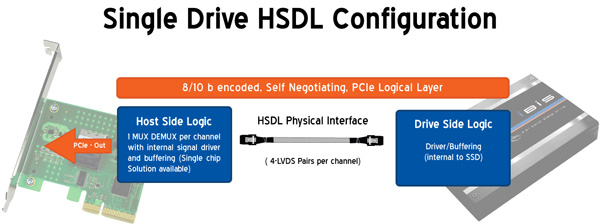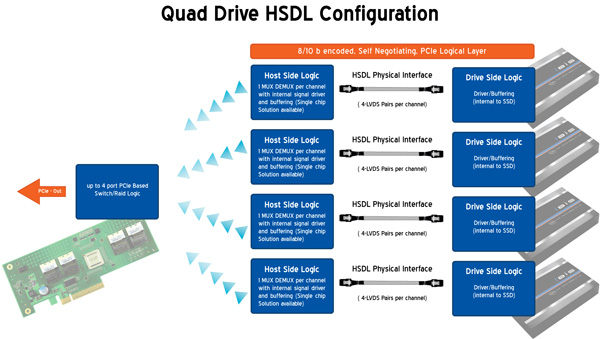OCZ's Fastest SSD, The IBIS and HSDL Interface Reviewed
by Anand Lal Shimpi on September 29, 2010 12:01 AM ESTTake virtually any modern day SSD and measure how long it takes to launch a single application. You’ll usually notice a big advantage over a hard drive, but you’ll rarely find a difference between two different SSDs. Present day desktop usage models aren’t able to stress the performance high end SSDs are able to deliver. What differentiates one drive from another is really performance in heavy multitasking scenarios or short bursts of heavy IO. Eventually this will change as the SSD install base increases and developers can use the additional IO performance to enable new applications.
In the enterprise market however, the workload is already there. The faster the SSD, the more users you can throw at a single server or SAN. There are effectively no limits to the IO performance needed in the high end workstation and server markets.
These markets are used to throwing tens if not hundreds of physical disks at a problem. Even our upcoming server upgrade uses no less than fifty two SSDs across our entire network, and we’re small beans in the grand scheme of things.
The appetite for performance is so great that many enterprise customers are finding the limits of SATA unacceptable. While we’re transitioning to 6Gbps SATA/SAS, for many enterprise workloads that’s not enough. Answering the call many manufacturers have designed PCIe based SSDs that do away with SATA as a final drive interface. The designs can be as simple as a bunch of SATA based devices paired with a PCIe RAID controller on a single card, to native PCIe controllers.

The OCZ RevoDrive, two SF-1200 controllers in RAID on a PCIe card
OCZ has been toying in this market for a while. The zDrive took four Indilinx controllers and put them behind a RAID controller on a PCIe card. The more recent RevoDrive took two SandForce controllers and did the same. The RevoDrive 2 doubles the controller count to four.
Earlier this year OCZ announced its intention to bring a new high speed SSD interface to the market. Frustrated with the slow progress of SATA interface speeds, OCZ wanted to introduce an interface that would allow greater performance scaling today. Dubbed the High Speed Data Link (HSDL), OCZ’s new interface delivers 2 - 4GB/s (that’s right, gigabytes) of aggregate bandwidth to a single SSD. It’s an absolutely absurd amount of bandwidth, definitely more than a single controller can feed today - which is why the first SSD to support it will be a multi-controller device with internal RAID.
Instead of relying on a SATA controller on your motherboard, HSDL SSDs feature a 4-lane PCIe SATA controller on the drive itself. HSDL is essentially a PCIe cable standard that uses a standard SAS cable to carry a 4 PCIe lanes between a SSD and your motherboard. On the system side you’ll just need a dumb card with some amount of logic to grab the cable and fan the signals out to a PCIe slot.
The first SSD to use HSDL is the OCZ IBIS. As the spiritual successor to the Colossus, the IBIS incorporates four SandForce SF-1200 controllers in a single 3.5” chassis. The four controllers sit behind an internal Silicon Image 3124 RAID controller. This is the same controller used in the RevoDrive which is natively a PCI-X controller, picked to save cost. The 1GB/s of bandwidth you get from the PCI-X controller is routed to a Pericom PCIe x4 switch. The four PCIe lanes stemming from the switch are sent over the HSDL cable to the receiving card on the motherboard. The signal is then grabbed by a chip on the card and passed through to the PCIe bus. Minus the cable, this is basically a RevoDrive inside an aluminum housing. It's a not-very-elegant solution that works, but the real appeal would be controller manufacturers and vendors designing native PCIe-to-HSDL controllers.
OCZ is also bringing to market a 4-port HSDL card with a RAID controller on board ($69 MSRP). You’ll be able to raid four IBIS drives together on a PCIe x16 card for an absolutely ridiculous amount of bandwidth. The attainable bandwidth ultimately boils down to the controller and design used on the 4-port card however. I'm still trying to get my hands on one to find out for myself.













74 Comments
View All Comments
mroos - Friday, November 5, 2010 - link
What PCI device do these IBISes provide? Is it something standard like AHCI that has drivers for every OS, or something proprietary that needs new driver written and integrated into all relevant OS-es?mroos - Friday, November 5, 2010 - link
OK, it looks like the interface to host is SiI 3124. This is widely supported sata HBA and has drivers for most operating systems.But SiI3124 is just SATA host controller - no RAID. So the RAID must be done host side, or sofRAID in other words. It also means Linux should see 4 distinct SSD devices.
paralou - Saturday, April 9, 2011 - link
Hello,I don't remember if i already posted my question, sorry !
But in installed one IBIS 160GB using the following configurated computer:
ASUS P6T WS Pro (latest BIOS & drivers)
Intel i7 Core 965 Extreme 3.2GHz
Kingston DDR3 1600MHz - 12GB
nVIDIA Quadro FX4800 grphics card
2 Seagate SAS 450GB
Microsoft Windows 7 Pro
After installing Win7 without problems, i installed antivirus BitDefender, several app's (including Adobe package and Microsoft Office Pro), configured Updates NOT AUTOMATIC !
When i stopped my computer, system started downloading 92 Upgrades (without my permission) ?
When i restarted..Crash error 0x80070002
Impossible to restor (i made an image system, but day before !)
Reinstalled, and while i was typing the Key codes for the Microsoft Vision Pro ..
An other crash ! Same problem !
My opinion, about the IBIS HSDL box, it's a very poor assembly design!
Impossible to connec the supply connector on it, and i must dismantle the front plater to have access to the supply connector !
Now, i wonder if i have to follow OCZ's advice about the BIOS configuration?
They are saying:
" You must set you BIOS to use "S1 Sleep Mode" for proper operation.
Using S3 or AUTO may cause instability ".
And what about the internal HDD's ?
Is there any member who already installed such IBIS and use it regularely.
If the answer is Yes (?) can you please tell me how you configured your system ?
Regards,
Paralou
MySchizoBuddy - Wednesday, February 22, 2012 - link
OCZ doesn't have PCIe x16 option like FusionIO ioDrive Octal which takes the reads to 6GB/s